Django Manage Commands
ST2/ST3 plugin for managing django project
Details
Installs
- Total 19K
- Win 8K
- Mac 4K
- Linux 7K
| Dec 23 | Dec 22 | Dec 21 | Dec 20 | Dec 19 | Dec 18 | Dec 17 | Dec 16 | Dec 15 | Dec 14 | Dec 13 | Dec 12 | Dec 11 | Dec 10 | Dec 9 | Dec 8 | Dec 7 | Dec 6 | Dec 5 | Dec 4 | Dec 3 | Dec 2 | Dec 1 | Nov 30 | Nov 29 | Nov 28 | Nov 27 | Nov 26 | Nov 25 | Nov 24 | Nov 23 | Nov 22 | Nov 21 | Nov 20 | Nov 19 | Nov 18 | Nov 17 | Nov 16 | Nov 15 | Nov 14 | Nov 13 | Nov 12 | Nov 11 | Nov 10 | Nov 9 | |
|---|---|---|---|---|---|---|---|---|---|---|---|---|---|---|---|---|---|---|---|---|---|---|---|---|---|---|---|---|---|---|---|---|---|---|---|---|---|---|---|---|---|---|---|---|---|
| Windows | 0 | 0 | 0 | 0 | 0 | 0 | 0 | 0 | 0 | 0 | 0 | 0 | 0 | 0 | 0 | 0 | 0 | 0 | 0 | 0 | 0 | 1 | 1 | 0 | 1 | 0 | 0 | 0 | 0 | 1 | 0 | 0 | 0 | 0 | 0 | 0 | 0 | 0 | 0 | 0 | 1 | 0 | 1 | 0 | 0 |
| Mac | 0 | 0 | 0 | 0 | 0 | 0 | 0 | 0 | 0 | 0 | 0 | 0 | 0 | 0 | 0 | 0 | 0 | 0 | 0 | 0 | 0 | 0 | 0 | 0 | 0 | 0 | 0 | 0 | 0 | 0 | 0 | 0 | 0 | 0 | 0 | 0 | 0 | 0 | 0 | 0 | 0 | 0 | 0 | 0 | 0 |
| Linux | 0 | 0 | 0 | 0 | 0 | 0 | 0 | 0 | 0 | 0 | 0 | 0 | 1 | 0 | 0 | 0 | 0 | 0 | 0 | 0 | 1 | 0 | 0 | 0 | 0 | 0 | 0 | 0 | 0 | 0 | 0 | 0 | 0 | 0 | 0 | 0 | 0 | 0 | 0 | 0 | 0 | 0 | 0 | 0 | 0 |
Readme
- Source
- raw.githubusercontent.com
____ _ __ __
| _ \(_) __ _ _ __ __ _ ___ | \/ | __ _ _ __ __ _ __ _ ___
| | | | |/ _` | '_ \ / _` |/ _ \ | |\/| |/ _` | '_ \ / _` |/ _` |/ _ \
| |_| | | (_| | | | | (_| | (_) | | | | | (_| | | | | (_| | (_| | __/
|____// |\__,_|_| |_|\__, |\___/ |_| |_|\__,_|_| |_|\__,_|\__, |\___|
|__/ |___/ |___/
____ _
/ ___|___ _ __ ___ _ __ ___ __ _ _ __ __| |___
| | / _ \| '_ ` _ \| '_ ` _ \ / _` | '_ \ / _` / __|
| |__| (_) | | | | | | | | | | | (_| | | | | (_| \__ \
\____\___/|_| |_| |_|_| |_| |_|\__,_|_| |_|\__,_|___/
Django manage commands
The best tool for your django development.
Overview
This tool is a Sublime Text wrapper around django manage.py commands.
So you can create new Django projects and apps directly from Sublime text like this
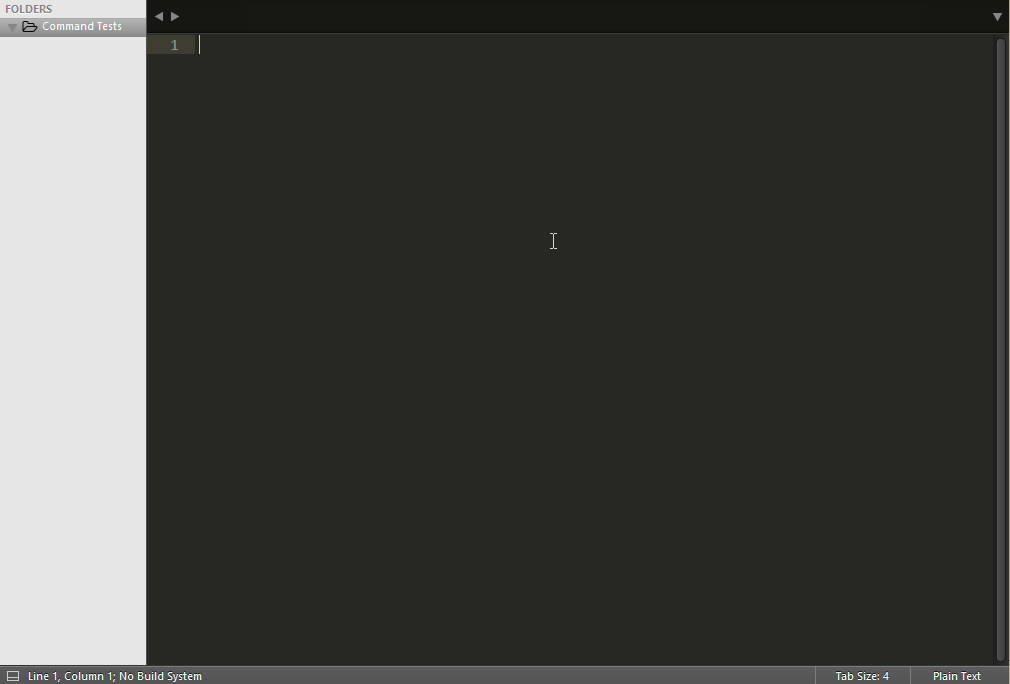
Make migrations, migrate the database or run tests
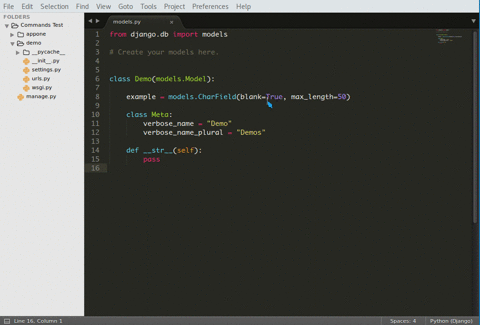
And run the test server
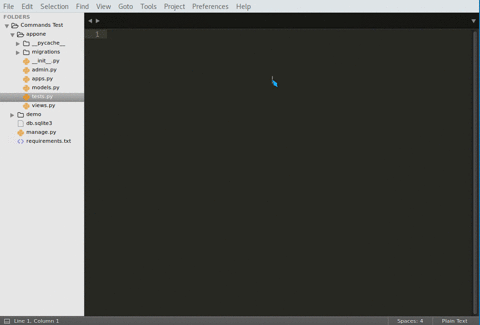
Even run tests
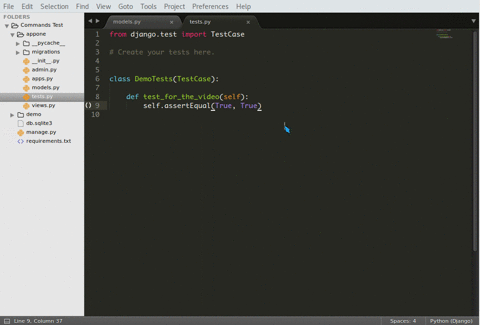
You can also run Django: Custom Command to access other manage.py commands. Try Django: Help and you will get full list of commands provided by each application.
Or you can choose to use Django: Other Command to list and run all commands available to manage.py
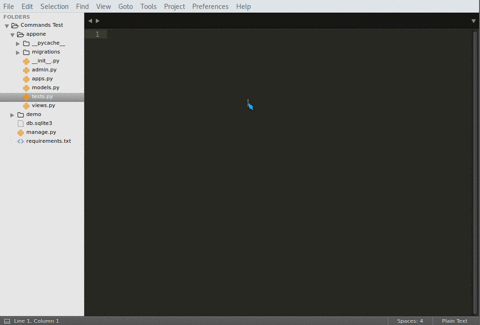
Currently tested on Windows 7/8/10, Mac OS, Ubuntu and many other linux distros.
Everything tested and running!
- Virtualenv support
- Django boilerplate
- Install your dependencies
- Install new pip packages
- Open and search in django documentation from the editor
- Run custom servers
- PostgreSQL specific features snippets
- And More!
Installation
Package Control
The easiest way to install this is with Package Control.
- If you just went and installed Package Control, you probably need to restart Sublime Text before doing this next bit.
- Bring up the Command Palette (Command+Shift+p on OS X, Control+Shift+p on Linux/Windows).
- Select “Package Control: Install Package” (it'll take a few seconds)
- Select
Django Manage Commandswhen the list appears.
Package Control will automatically keep plugin up to date with the latest version.
Use
Commands
Currently supports following commands:
Django:
Django: New ProjectDjango: New AppDjango: Run ServerDjango: Run Custom ServerDjango: BoilerplateDjango: TestDjango: Test AllDjango: ShellDjango: DB ShellDjango: Custom CommandDjango: Other CommandDjango: CheckDjango: HelpDjango: Open DocsDjango: Search in DocsDjango: Make MigrationDjango: SQLMigrationDjango: Migrate DatabaseDjango: List MigrationsDjango: Click
Virtual Environment:
Django: Set Virtual EnvironmentDjango: Terminal HereDjango: Pip FreezeDjango: Pip Freeze To FileDjango: Pip Install PackagesDjango: Pip Install RequirementsDjango: Set Project InterpreterDjango: Use Default Interpreter
Settings
python_bin: path to python interpreterpython_version: default python interpreter versionpython_virtualenv_paths: list of paths where virtualenvs are located (ex:~/.virtualenvs/)*server_host: host for the runserver commandserver_port: port for the server to listenlinux_terminal: Linux only, used to define a custom command line emulator**osx_terminal: Mac OSX only, used to define a custom terminal emulator.***browser_after_runserver: set true to open a browser pointing to the root url after a run server command.project_override: (Boolean) Per project setting “python_interpreter” overrides “python_bin”server_custom_command: Per project setting to specify a custom server to run
Each setting has it's own explanation and some examples of use at the default settings file.
*It's important to set your envs directories
*The folders in this list should be the parent folder of the virtualenv folder, not the virtualenv folder itself
**Default is x-terminal-emulator with a fallback to xterm
***Default is Terminal
